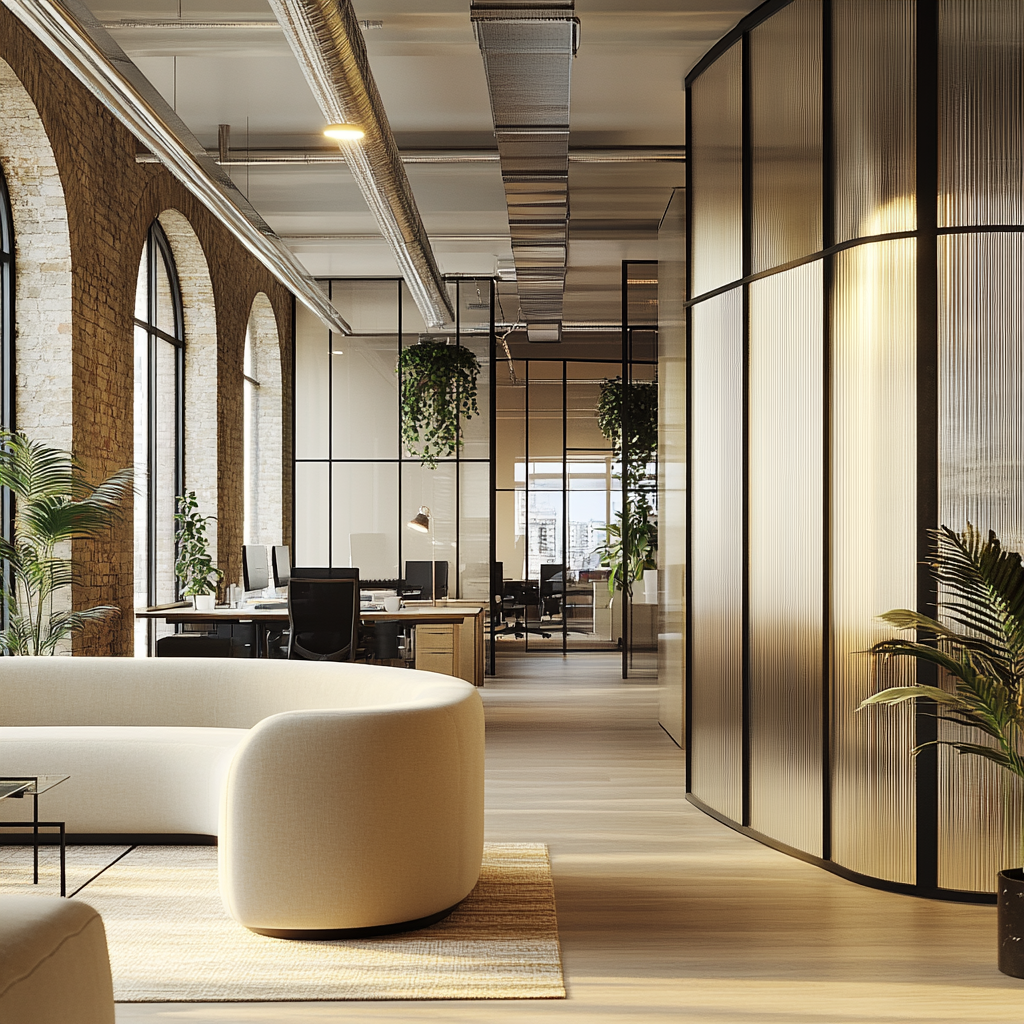Optimising Productivity in Open Plan Offices.
Today’s workplaces need to work hard, to support productivity and wellbeing in open offices. By adding effective acoustic solutions, bustling offices can become peaceful spaces that improve efficiency and employee health. Imagine an office with ergonomic design and calming natural elements, where sound management helps focus and supports a healthier work environment.
Understanding Acoustic Challenges.
Ai Visualisation of open plan office using reeded acoustic glass, incorporating biophilia and natural light.
Noise Sources.
Open-plan offices often are known to suffer noise, that often leads to productivity disrupted. Conversations, phone calls, general footfall and printer noise create a constant background hum. Computer equipment and ventilation add to the noise. Meetings and casual chats increase this noise level, making it hard to keep a healthy office environment. Even typing sounds can be distracting. These noises hinder concentration and memory, raising stress levels. This shows why effective acoustic solutions are important. Strategic design, such as arranging ergonomic furniture and using sound-absorbent materials, can manage these noise sources. Flexible office spaces with focused work zones and collaborative areas can also help solve these acoustic challenges.
Bad acoustics in open-plan offices has a huge impact on productivity and wellbeing. Constant noise lowers concentration, making it hard to focus on tasks. This distraction cuts efficiency and affects memory. Over time, loud noise can increase absenteeism and reduce job satisfaction. Employees can feel mentally drained, leading to less creativity and innovation. Noise can also cause frustration and tension, affecting teamwork. By using acoustic solutions like sound-absorbing materials and smart space planning, businesses can create better office environments. This proactive approach lowers disturbances and helps employees thrive.
Acoustic pod design
Exploring acoustic booth design using reeded wood steam bent solutions as a group pod.
Strategic Sound Absorption.
Managing noise in open-plan offices requires strategic sound absorption. Using sound-absorbing materials on room surfaces can lower noise levels and improve productivity. Ceiling treatments help a lot because of their large surface area. These can be paired with wall solutions to tackle sound echoes and reflections, especially near workstations. Absorbent materials at ear height can help with these issues. Flooring is key, as it can reduce footfall noise and floor vibrations. Choosing sound-absorbing flooring contributes to a calmer environment. These thoughtful acoustic solutions enhance the office atmosphere and maintain a healthy workplace. Using these strategies ensures the space is good for both focus and teamwork.
Furniture placement is crucial for effective acoustic solutions in open-plan offices. Grouping workstations enhances collaboration and reduces noise by concentrating conversations. This setup allows for sound-absorbing panels to contain noise. Placing workstations away from walls reduces sound reflections and echoes, creating better acoustics. Using ergonomic furniture with padded elements also helps absorb sound, improving employee wellbeing. Designing separate closed areas for meetings or phone calls helps manage noise. By thoughtfully placing furniture, businesses can create flexible spaces that meet diverse needs without losing acoustic quality. This smart approach ensures the office supports focus and teamwork, helping productivity thrive.
Acoustic pod design
Exploring acoustic booth design using reeded wood steam bent solutions in separate pods.
Integrating Biophilic Design.
Bringing nature into the office improves wellbeing. This involves using natural elements like plants and materials to connect with nature. These elements improve air quality and create a calming atmosphere, lowering stress and boosting productivity. Natural light and views of greenery further enhance employees' mental and physical health. Biomorphic designs—natural patterns and shapes—can also be used in furniture and decor to make an inspiring space. This design works with acoustic solutions to tackle both visual and sound distractions. By creating a biophilic environment, businesses can improve employee health and productivity, leading to a more engaged workforce.
Flexible office spaces are key to improving wellbeing and meeting diverse needs. Creating adaptable areas supports different work styles, from teamwork to focused tasks. Movable walls, adjustable furniture, and multi-functional rooms allow for easy transitions between activities, promoting a dynamic work environment. These spaces give employees control over their surroundings, increasing job satisfaction and productivity. Quiet zones and breakout areas help manage noise, enhancing acoustic quality. This flexibility goes well with ergonomic furniture and biophilic design, creating a holistic office approach that addresses physical comfort and mental wellbeing. By prioritising flexible spaces, businesses foster an environment that encourages innovation and collaboration, supporting a thriving workforce.
Ai visualisation of open plan office using reeded glass and biophilic elements.
A few helpful tips:
Incorporate elegant acoustic panels/ consider acoustic glass
Add soft furnishings
Look at sustainable acoustic flooring solutions
Explore biophilia
Our interior design and project management services are designed to meet these goals, and support you in the creation of successful workspace environments, while also focusing on sustainability. Join our satisfied clients who enjoy beautifully designed, sustainably considered workspace and healthcare environments, and let us help you create an inspiring space that motivates your team to succeed.




